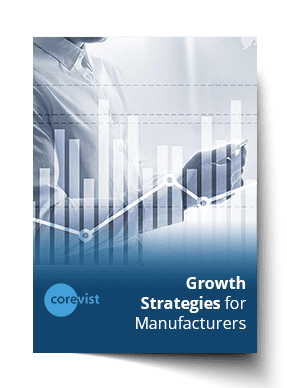Share
Author
Corevist Marketing Team
Share
In today’s rapidly evolving business landscape, building strong customer relationships through digital channels is more crucial than ever for manufacturers. This is where B2B portals shine, going beyond simply shifting existing revenue online.
Their true potential lies in unlocking new avenues for growth with your existing clientele, a much more efficient strategy than chasing after new leads. Curious to know how?
Here are 8 powerful ways a B2B portal can fuel sales growth from your existing accounts:
1. Offer personalized catalogs and picklists
Customers love personalization. It shows you know them and their needs, and it makes the ordering process much easier—which translates into repeat visits and more orders.
This is especially true when it comes to catalogs and picklists. If you have a giant catalog, or if some SKUs aren’t relevant to some customers, you can create a smoother portal experience if you only show customers the things they care about.
But that’s not the only use for personalized catalogs and picklists. They also come in handy if customers want to build orders that fill up a truckload (so they can maximize the value of their freight charges). This is an ingenious way to increase order size in the B2B portal.
Learn more here: The Power Of Personalized Picklists.
2. Honor personalized pricing rules in the portal
If all your customers receive the same pricing on every SKU, then this may not matter at your organization. However, if customers have unique pricing defined in SAP ERP, then the portal had better reflect their pricing in real time.
If pricing is wrong, customers won’t be able to complete transactions online. This introduces friction to the process of building and placing an order. In fact, you can lose the sale if customers have to interrupt the self-service process to place a phone call. If they’re choosing between you and a supplier with an easy online ordering experience (with correct pricing), then accurate contract pricing can make or break the sale.
3. Engage cross-selling and upselling relationships in the portal
No product lives in a vacuum. Between related products and upsells, there’s plenty of opportunity to increase your value to customers in a B2B portal.
Ideally, your portal should support your cross-selling and upselling relationships so you can introduce customers to higher-value purchases. This is a crucial component of any drive to increase digital revenue.
You may have these relationships defined in SAP ERP, but how do you bring them to the web?
Hint: A deep, prebuilt SAP integration can provide this, and Corevist Commerce includes it out of the box.
4. Consider selling third-party supporting products alongside your own
Chances are, your products aren’t the only thing customers are buying to fulfill a larger need at their organization.
If you’re selling a machine, customers may also need to buy a third-party lubricant to keep the machine running smoothly.
If you’re selling sophisticated medical devices, customers may also need consumables to use alongside the device.
Whatever business you’re in, chances are, there are supporting products that your customers need alongside your specialty product. Why not sell those in the portal, acting like a distributor? It’s a great way to gain a larger share of the customer’s wallet.
Read more here: Why Manufacturers Should Consider Selling 3rd Party Products.
5. Use email marketing to drive related and repeat purchases
A B2B portal acts as a customer destination for all things product-related. Once you have a portal, you can drive traffic to category pages and specific products. This opens up all kinds of possibilities for email marketing. The more intelligence you have on customer behavior, the more you can segment customers—which means you can send highly relevant, personalized messages.
For example, say a customer purchased a major product but didn’t purchase any associated consumables. In an email automation solution like ActiveCampaign or Hubspot, you can define a path for this type of user, sending them an email (or three) outlining the benefits of these supporting products and linking to them in the portal.
If your products have a finite lifecycle, you can get even more sophisticated. When you phase out Product A and replace it with Product B, the first segment you should contact is those customers who bought Product A. Let them know that Product B is coming out—and what makes it such a great upgrade. Linking to all the product information in your portal makes it easy for customers to self-educate and make a purchase.
6. Make sure your portal supports different user permissions and ordering workflows
How do your customers build and approve orders?
If one person handles the task from start to finish, then this may not apply at your organization. However, if different people build and approve orders, then your portal needs to support this complexity and the associated workflow. Typically, this means allowing a user with fewer privileges to build an order and notify their manager, who has the appropriate permissions to place the order.
Without a B2B ordering portal, your customers will have to develop their own system for proposing and approving orders. You can make yourself “easier to do business with” if your B2B portal supports their approval process. When you take out this friction in the customer journey, customers have a greater incentive to buy from you rather than the competition.
7. Make sure your portal shows real-time credit status (and supports online payments)
It might seem counterintuitive, but stick with us. When manufacturers show customers how much they owe in the portal, it can actually increase sales.
Why?
Because a buyer who needs her order now may buy from another supplier if the order will go on credit block with you. And without that real-time visibility into credit status, she can’t tell what will happen after she places the order.
Of course, she can call customer service, but that defeats the purpose of a self-service portal. Hence the need to show real-time credit status in the portal.
When you couple this credit status visibility with online payments, your portal becomes especially powerful. Now, users with the appropriate permissions can come in and pay down their balance right away, opening up more credit for new orders. With friction in this process removed, customers are free to pay and place new orders on their own terms.
8. Onboard your sales reps to the B2B portal
Is there any reason your reps can’t use the portal alongside customers?
Nope! (Assuming the portal supports their needs.)
In fact, a B2B portal makes a great destination for sales reps. If it supports multiple customer accounts and on-behalf-of ordering (as Corevist does), it can give each rep the exact experience that the customer gets in the portal. This includes personalized pricing, personalized catalogs, credit status, order history, and so on.
In other words, a B2B portal is a powerful tool for intelligent selling. Reps can see related products and upsells, not to mention check bundled pricing and advise on account status. A good portal solution should be easier to use than SAP GUI, which will help ensure your reps actually adopt it.
The takeaway
If you need to increase sales, the first place to look is existing customers. And the easiest way to increase your value to existing customers is to offer a B2B portal that’s intuitive and easy to use. When you bring together personalization, merchandising, and self-service, you create a powerful experience that meets customers where they’re at and increases your bottom line.
NEW Report:
Growth Strategies for Manufacturers
Every manufacturer needs to grow in the digital age. Here’s the ultimate guide to growth strategies for manufacturers. Read now.










